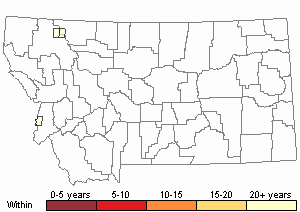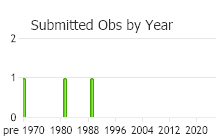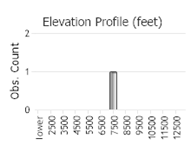View in other NatureServe Network Field Guides
NatureServe
Montana
Utah
Wyoming
Idaho
Wisconsin
British Columbia
South Carolina
Yukon
California
New York
A Pocket Moss - Fissidens osmundioides
General Description
Plants: Acrocarpous, growing in open clumps of upright shoots, green or green with yellow tones distally, brown proximally (Lawton 1971). Stems to 21 mm tall, the branching simple or sparse, possessing a central strand (FNA 2007); rhizoids brown, tangled into mats (Lawton 1971), and papillose (FNA 2007).
Leaves: Laxly spaced (FNA 2007) or sometimes overlapping a little, more distant below than above, the ends recurved when dry (Lawton 1971), typically broadest just below mid-leaf, lance-shaped (FNA 2007) to egg-shaped or somewhat oblong (Lawton 1971), tapering to an obtuse or nearly obtuse leaf tip, occasionally apiculate, 0.7-2 mm in length and to 0.7 mm in width, to 20 pairs, 2-ranked, enveloping the stem closely; vaginant laminae 1/2 the length of the leaf or somewhat longer, about equal to each other in length (FNA 2007), and broader than the apical lamina (Lawton 1971); dorsal lamina ending at or occasionally before the leaf base; margins scalloped to evenly and finely saw-toothed above, not bordered; costa ending just before to 14 cells before the leaf tip (FNA 2007), sometimes a little wavy distally (Crum & Anderson et al., 1981).
Leaf Cells: Lamina 1 cell-layer thick, the cells more-or-less 6-sided with firm walls (FNA 2007).
Diagnostic Characteristics
The similar F. adianthoides has a light-colored strip of marginal cells, and non-papillose rhizoids, unlike F. osmundioides. In addition, its sporophytes are in lower leaf axils rather than terminal at the stem apices (FNA 2007).
Range Comments
North American Range
AK to NU, BC to NL and NS, s to OR, ID, and MT, also CO, KS and OK, and most states of the eastern half of the United States (except LA, MS, FL, WV, MD, RI, and DE) (FNA 2007). Known in Montana from Flathead and Glacier Counties (Elliott & Pipp, 2016).
Observations in Montana Natural Heritage Program Database
Number of Observations: 5
(Click on the following maps and charts to see full sized version)
Map Help and Descriptions
Relative Density

Recency



 (Observations spanning multiple months or years are excluded from time charts)
(Observations spanning multiple months or years are excluded from time charts)
Habitat
Shady, wet areas, acidic and nonacidic surfaces (Crum & Anderson et al., 1981), on stones near moving water, sometimes receiving the spray, moist soil and humus of seeps (FNA 2007), soil on top of stones, stone shelves on bluffs, logs (Lawton 1971), around tree bottoms, wetlands and meadows (FNA 2007).
Reproductive Characteristics
Dioicous. Both male and female structures on somewhat long stems. Seta 1 to a perichaetium, to 2.5 mm in height (FNA 2007) or sometimes to 7 mm, terminal (Crum & Anderson et al., 1981). Capsule to 1 mm in length; stomata scarce below (FNA 2007); operculum about as long as the theca or longer; peristome single, the 16 teeth red and with papillae proximally (Lawton 1971) in longitudinal rows, and striations above (Crum & Anderson et al., 1981). Calyptra cone-shaped, 1.5 mm length (FNA 2007).
Stewardship Responsibility
References
- Literature Cited AboveLegend:
 View Online Publication
View Online Publication Crum, H.A. and L.E. Anderson. 1981. Mosses of Eastern North America. 2 volumes. Columbia University Press, New York. 1328 pp.
Crum, H.A. and L.E. Anderson. 1981. Mosses of Eastern North America. 2 volumes. Columbia University Press, New York. 1328 pp. Elliott, J.C. and A.K. Pipp. 2018. A Checklist of Montana Mosses (1880-2018). Updated 3 January, 2020. Montana Natural Heritage Program, Helena, Montana. 73 pp.
Elliott, J.C. and A.K. Pipp. 2018. A Checklist of Montana Mosses (1880-2018). Updated 3 January, 2020. Montana Natural Heritage Program, Helena, Montana. 73 pp. Flora of North America Editorial Committee, eds. 2007. Flora of North America North of Mexico. Volume 27. Bryophytes: Mosses, Part 1. Oxford University Press, Inc., NY. xxi + 713 pp.
Flora of North America Editorial Committee, eds. 2007. Flora of North America North of Mexico. Volume 27. Bryophytes: Mosses, Part 1. Oxford University Press, Inc., NY. xxi + 713 pp. Lawton, E. 1971. Moss Flora of the Pacific Northwest. Hattori Botanical Laboratory. Japan: Yamabuki-cho, Shinjuku-ku, Tokyo. 362 pages plus appendices.
Lawton, E. 1971. Moss Flora of the Pacific Northwest. Hattori Botanical Laboratory. Japan: Yamabuki-cho, Shinjuku-ku, Tokyo. 362 pages plus appendices.
- Additional ReferencesLegend:
 View Online Publication
View Online Publication
Do you know of a citation we're missing? Elliot, J. C. 1993. Second checklist of Montana mosses. Unpublished report. U.S. Forest Service, Region 1. Missoula, MT. 45 pp.
Elliot, J. C. 1993. Second checklist of Montana mosses. Unpublished report. U.S. Forest Service, Region 1. Missoula, MT. 45 pp. Lawton, E. 1971. Keys for the Identification of the Mosses on the Pacific Northwest. Reprinted from 'Moss Flora of the Pacific Northwest'. Published as Supplement No. 2 of the Journal of the Hattori Botanical Laboratory. Nichinan, Miyazaki, Japan. 66 pp.
Lawton, E. 1971. Keys for the Identification of the Mosses on the Pacific Northwest. Reprinted from 'Moss Flora of the Pacific Northwest'. Published as Supplement No. 2 of the Journal of the Hattori Botanical Laboratory. Nichinan, Miyazaki, Japan. 66 pp. Smith, A.J.E. 1980. The Moss Flora of Britain and Ireland. Cambridge University Press, Cambridge. 705 pp.
Smith, A.J.E. 1980. The Moss Flora of Britain and Ireland. Cambridge University Press, Cambridge. 705 pp.
- Web Search Engines for Articles on "A Pocket Moss"





